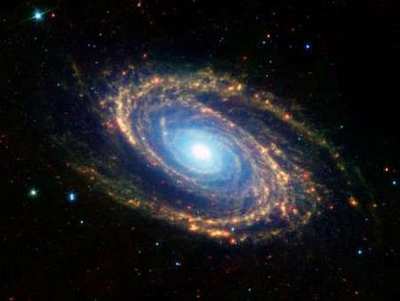Hiding The Light Of 10 Trillion Suns
 How do you hide something as big and
bright as a galaxy? You smother it in cosmic dust. NASA's Spitzer
Space Telescope saw through such dust to uncover a hidden
population of monstrously bright galaxies approximately 11 billion
light-years away.
How do you hide something as big and
bright as a galaxy? You smother it in cosmic dust. NASA's Spitzer
Space Telescope saw through such dust to uncover a hidden
population of monstrously bright galaxies approximately 11 billion
light-years away.
These strange galaxies are among the most luminous in the
universe, shining with the equivalent light of 10 trillion suns.
But, they are so far away and so drenched in dust, it took
Spitzer's highly sensitive infrared eyes to find them.
"We are seeing galaxies that are essentially invisible," said
Dr. Dan Weedman of Cornell University, Ithaca, NY, co-author of the
study detailing the discovery, published in today's issue of the
Astrophysical Journal Letters. "Past infrared missions hinted at
the presence of similarly dusty galaxies over 20 years ago, but
those galaxies were closer. We had to wait for Spitzer to peer far
enough into the distant universe to find these."
Where is all this dust coming from? The answer is not quite
clear. Dust is churned out by stars, but it is not known how the
dust wound up sprinkled all around the galaxies. Another mystery is
the exceptional brightness of the galaxies. Astronomers speculate
that a new breed of unusually dusty quasars, the most luminous
objects in the universe, may be lurking inside. Quasars are like
giant light bulbs at the centers of galaxies, powered by huge black
holes.
Astronomers would also like to determine whether dusty, bright
galaxies like these eventually evolved into fainter, less murky
ones like our own Milky Way. "It's possible stars like our Sun grew
up in dustier, brighter neighborhoods, but we really don't know. By
studying these galaxies, we'll get a better idea of our own
galaxy's history," said Cornell's Dr. James Houck, lead author of
the study.

The Cornell-led team first scanned a portion of the night sky
for signs of invisible galaxies using an instrument on Spitzer
called the multiband imaging photometer. The team then compared the
thousands of galaxies seen in this infrared data to the deepest
available ground-based optical images of the same region, obtained
by the National Optical Astronomy Observatory Deep Wide-Field
Survey. This led to identification of 31 galaxies that can be seen
only by Spitzer. "This large area took us many months to survey
from the ground," said Dr. Buell Jannuzi, co-principal investigator
for the Deep Wide-Field Survey, "so the dusty galaxies Spitzer
found truly are needles in a cosmic haystack."
Further observations using Spitzer's infrared spectrograph
revealed the presence of silicate dust in 17 of these 31 galaxies.
Silicate dust grains are planetary building blocks like sand, only
smaller. This is the furthest back in time that silicate dust has
been detected around a galaxy. "Finding silicate dust at this very
early epoch is important for understanding when planetary systems
like our own arose in the evolution of galaxies," said Dr. Thomas
Soifer, study co-author, director of the Spitzer Science Center,
Pasadena, CA, and professor of physics at the California Institute
of Technology, also in Pasadena.
This silicate dust also helped astronomers determine how far
away the galaxies are from Earth.
"We can break apart the light from a distant galaxy using a
spectrograph, but only if we see a recognizable signature from a
mineral like silicate, can we figure out the distance to that
galaxy," Soifer said.

In this case, the galaxies were dated back to a time when the
universe was only three billion years old, less than one-quarter of
its present age of 13.5 billion years. Galaxies similar to these in
dustiness, but much closer to Earth, were first hinted at in 1983
via observations made by the joint NASA-European Infrared
Astronomical Satellite. Later, the European Space Agency's Infrared
Space Observatory faintly recorded comparable, nearby objects. It
took Spitzer's improved sensitivity, 100 times greater than past
missions, to finally seek out the dusty galaxies at great
distances.
 ANN's Daily Aero-Term (04.25.24): Airport Rotating Beacon
ANN's Daily Aero-Term (04.25.24): Airport Rotating Beacon ANN's Daily Aero-Linx (04.25.24)
ANN's Daily Aero-Linx (04.25.24) Klyde Morris (04.22.24)
Klyde Morris (04.22.24) Airborne 04.24.24: INTEGRAL E, Elixir USA, M700 RVSM
Airborne 04.24.24: INTEGRAL E, Elixir USA, M700 RVSM Airborne 04.22.24: Rotor X Worsens, Airport Fees 4 FNB?, USMC Drone Pilot
Airborne 04.22.24: Rotor X Worsens, Airport Fees 4 FNB?, USMC Drone Pilot





